Sun news February 29, 2024: Sun-stuff coming our way
The EarthSky sun news team created this video for you. Thanks for watching!
A huge bubble of plasma is on its way to Earth! The coronal mass ejection (CME) was observed by the SOHO spacecraft at around 11 UTC on February 28. It’s expected to give Earth a glancing blow on March 2, disturbing our magnetic field. The CME came from a C5.1 flare on February 28, fired almost precisely as Saturn and Mercury aligned with Earth behind the sun, reaching what’s known as superior conjunction – check it out in the video above. We also saw another potentially Earth-bound CME when AR3590 fired an M1.3 flare yesterday evening. Analysis of the CME this flare produced is still ongoing, but it looks like it may also have an Earth-directed component. Stay tuned!
Last 24 hours: Small prominences have been dancing on the upper left limb (edge) over the past day, while a bigger prominence erupted in the southeast. An isolated M1.3 flare from giant sunspot region AR3590 brought activity levels to moderate. Seven flares – an M and six Cs – were produced between 11 UTC yesterday and 11 UTC today. The largest was the M1.3 flare from AR3590 at 18:19 UTC on February 28. Shortly after the M1.3 flare an R1 (minor) radio blackout affected an area over Galapagos on the Pacific Ocean. AR3590 remains the lead flare producer, with four flares over the past day. The sun currently has seven active regions on its Earth-facing side. The newest region, AR3597, is located on the northeast quadrant. Helioseismology shows a big sunspot region behind the horizon in the southeast rotating our way.
??Sun news February 29, 2024: Sun stuff coming our way
??A CME was observed Feb 28. A glancing blow is expected on March 2.
??AR3590 released an M1.3 flare & CME. Analysis is underway to determine any Earth-directed component.
?MORE EarthSky: https://t.co/xD29wLfm4e pic.twitter.com/EP2zptB2Lb
— Dr. C. Alex Young (@TheSunToday) February 29, 2024
Sun news February 28, 2024: Saturn and Mercury both behind the sun today
The EarthSky sun news team created this video for you. Watch Saturn and Mercury get close!
Saturn and Mercury both reach superior conjunction today. That is, both Mercury (the little world closest to our sun) and Saturn (the 6th planet outward from the sun) are traveling behind the sun today as seen from Earth. And – the SOHO spacecraft’s LASCO C3 instrument shows us the two planets today. That black disk in the center is the sun, blotted from view in this image to reduce its glare. Wouldn’t all stargazers from all earlier generations on Earth have been jealous? Check it out in the video above; Mercury is coming in from the solar west (right), and Saturn from the solar east (left). Though Saturn has a diameter more than 20 times that of Mercury, it’s so much further away from us that it appears the smaller and dimmer of the two. How far are they? Today, Saturn is about 89 light-minutes from Earth. And today Mercury – now behind the sun from us – is about 12 light-minutes from Earth. Conjunctions really put things in perspective!
Last 24 hours: Giant sunspot region AR3590, the source of three X flares, has remained the lead flare producer. However, its overall activity has decreased, bringing sun activity levels to low. Only 15 C flares were produced between 11 UTC yesterday and 11 UTC today, eight of which came from AR3590. The largest event of the day was a C5.2 flare from AR3590 at 9:09 UTC, February 28. The sun currently has six active regions on its Earth-facing side.
? ? Sun news Feb 28, 2024: Saturn and Mercury conjunction with the sun
? ?Saturn and Mercury will be in superior conjunction. SOHO LASCO C3 shows the two planets moving toward each other.
? Giant region AR3590 hanging around.
? MORE EarthSky: https://t.co/xD29wLfm4e pic.twitter.com/aQpWC278Ga
— Dr. C. Alex Young (@TheSunToday) February 28, 2024
Sun news February 27, 2024: Aurora! Giant sunspot still in view
The EarthSky sun news team created this video for you. Thanks for watching!A blob of solar material fired out by the sun on February 21 appears to have glanced Earth, causing beautiful auroral displays at high latitudes. Fairbanks, Alaska and Ny-Ålesund and Dombås, Norway, reported auroras – take a look in the video above. Given giant sunspot region AR3590’s major activity over the past week, including 3 X flares in 2 days, you might expect that it was the culprit for this blast of sun-stuff. But actually, it came from a filament eruption in another part of the sun. Massive AR3590 – the largest active region of the current solar cycle, at seven times the surface area of Earth – hasn’t yet caused any geomagnetic disturbance here on Earth. But there’s still time; though it will soon rotate out of view, this sunspot group is currently positioned well to fire a coronal mass ejection (CME) our way, and possibly cause some more auroras. And as the region moves closer to the solar limb (edge), there’s a greater chance that it will cause a solar energetic particle storm. Stay tuned.
Last 24 hours: Giant sunspot group AR3590 continues to produce most of the activity, so now that the region has decreased slightly in size and magnetic complexity, activity has decreased to low. Only 10 C flares were produced between 11 UTC yesterday and 11 UTC today. Eight of the ten were produced by AR3590. The largest event of the day was a C3.5 flare from AR3590 at 7:42 UTC, February 27. The sun has six active regions on its Earth-facing side and today. Four of the regions have formed a vertical line, from north to south: AR3595, AR3594, AR3592 and AR3591. An interesting though coincidental sight.
? ? Sun news Feb 26, 2024: Aurora! AR3590 holding onto giant size
? AR3590 continues to drive most activity.
? ? February 21 CME caused auroral displays at high latitudes, e.g. Fairbanks and Norway.
? MORE at EarthSky: https://t.co/xD29wLfm4e pic.twitter.com/qOsn7BGxQS
— Dr. C. Alex Young (@TheSunToday) February 27, 2024
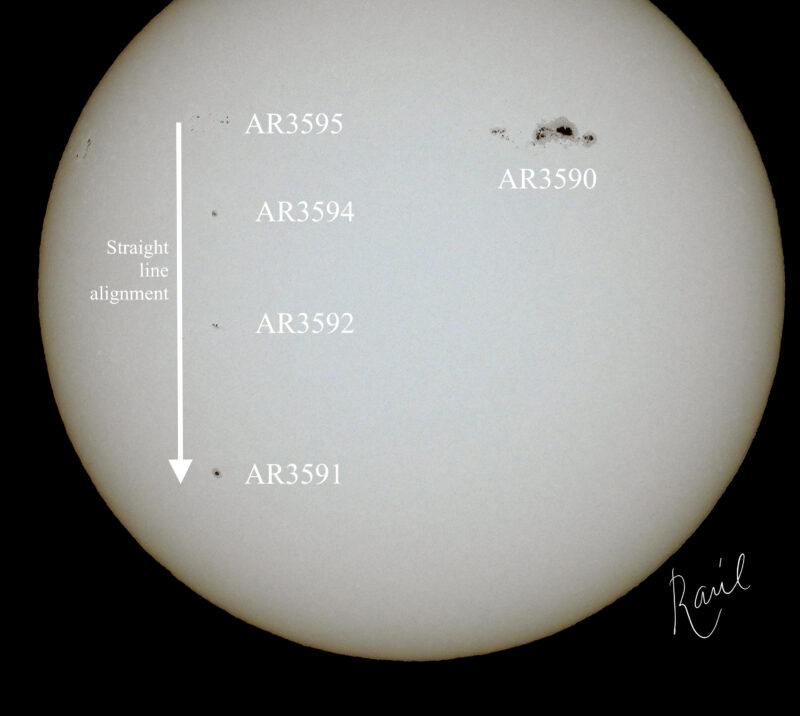
Sun news February 26, 2024: Get out your eclipses glasses NOW!
The EarthSky sun news team and our own Kelly Kizer Whitt have a word of advice of you. Don’t miss this sunspot!Sunspot group AR3590 is now the largest sunspot region of Solar Cycle 25. It spans 9.5 times the surface area of Earth, or 1,600 millionths of the visible solar hemisphere. Will the region release more large flares that include an associated coronal mass ejection (CME)? This active region (AR) released three X flares over two days late last week, including the largest X flare of Solar Cycle 25 so far. Interestingly, none of these flares produced measurable CMEs. This is not the first time this has happened. In October 2015, there was a massive active region named AR2192. It maintained the record as the largest active region for 24 years! And it was the most prolific flare producer of the last solar cycle – Solar Cycle 24 – with six X flares. AR2192 was 14 times the surface area of Earth. And, like our current big sunspot AR3590, the earlier region AR2192 produced no CMEs. While not yet studied in detail, AR3590 appears -like region AR2192 – to have an overlying magnetic field structure that restricts the eruptive nature necessary to produce CMEs. Now we wait! We’ll see if AR3590 continues the trend of no CMEs. We don’t know about you … but we’re excited to see how this plays out!
Last 24 hours: Sun activity is moderate with the production of one M flare from giant sunspot region AR3590. Between 11 UTC yesterday and 11 UTC today, the sun produced a total of 8 flares: one M and 7 Cs. The largest was an M2.1 flare flare from sunspot region AR3590 at 16:47 UTC on February 25. The M flare produced an R1 (minor) radio blackouts over South America. AR3590 produced all the period’s flares. The sun has seven labeled active regions on its Earth-facing side.
? ? Sun news for Feb 26, 2024
? ? ? AR3590 is now the largest sunspot region of solar cycle 25, 9.5 times Earth’s surface area. Will the region release more large flares with a CME?
? ? MORE at EarthSky: https://t.co/xD29wLfm4e pic.twitter.com/6crEVKnB0H
— Dr. C. Alex Young (@TheSunToday) February 26, 2024
Sun news for February 25, 2024: Will this mega-sunspot bring auroras?
The EarthSky sun news team created this video for you. Mega-sunspot region AR3590 is now capable of affecting Earth!
The sun’s rotation has now carried mega-sunspot region AR3590 into a prime position for lighting up Earth’s skies with auroras. This region released 3 X flares – including the biggest flare yet in Solar Cycle 25 – late last week. But it has yet to throw out any big chunk of solar material and magnetic fields – aka a coronal mass ejection or CME – which could then travel across space and create unearthly displays of auroras. If it’s going to do it, now’s the time! It’s now in the perfect location on the sun’s visible disk, a geoeffective position, where it’s capable of causing a geomagnetic disturbance. For a short period after its large flares, this region lost some of its magnetic complexity and physical size. But now it has gained back its magnetic energy and grown in size to over nine Earths in surface area. So – although the X flares of late last week had no associated Earthward CMEs – the opportunity for the region to send excitement our way is NOW. The higher probability for X flares remains at 30%. Will the region release more of its massive energy potential as a CME? And will the CME strike Earth directly and give us a great show? Inquiring minds want to know. Stay tuned!
Last 24 hours: Sun activity is moderate with the production of two M flares from giant sunspot region AR3590. Between 11 UTC yesterday and 11 UTC today, the sun produced a total of 11 flares: two Ms and 9 Cs. The largest was an M3.6 flare flare from sunspot region AR3590 at 11:03 UTC on February 24. The region produced an M1.0 flare at 11:54 UTC on February 24. Both of the M flares produced R1 (minor) radio blackouts over Africa. AR3590 produced all the period’s flares. The sun has five labeled active regions on its Earth-facing side.
BTW everyone … did the recent X flares cause the widespread cell phone outages in North America on Feburary 22? See the video below:
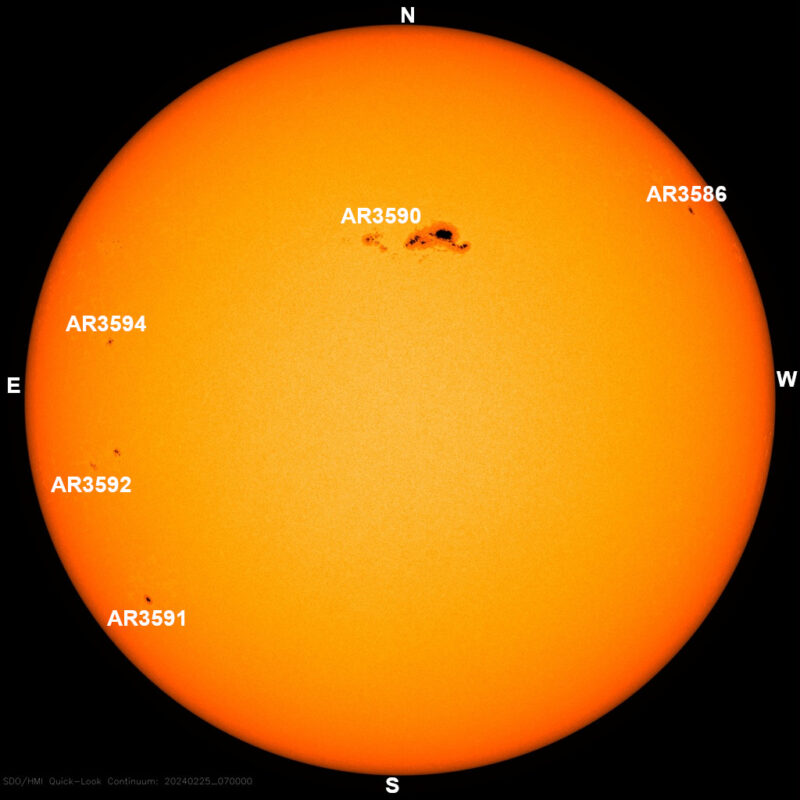
Sun news for February 24, 2024: Giant sunspot AR3590 is making history
The EarthSky sun news team produced this video for you. Get out your eclipse glasses and look for AR3590!
Remember a couple of weeks ago, when we reported on a huge active region on the sun’s far side that was flaring so mightily it made the sun vibrate in a special mode? That farside active region was AR3590, now giant-sized and visible on the Earth-facing side of our star. The region is currently a dark blotch on the sun’s visible surface – many times Earth’s diameter – visible through your eclipse glasses! And this region has been making history. It produced the biggest X flare of Solar Cycle 25 so far, an X6.4, late in the day on February 22. That big X flare brought the number of X flares up to three produced by AR3590 in less than 24 hours. And today … six more moderate-sized flares – M flares – from AR3590! Plus, AR3590 has remained as the leading flare producer of the past day. Good job, AR3590!
Last 24 hours: Sun activity is back to moderate, after the production of six M flares from giant sunspot region AR3590. Between 11 UTC yesterday and 11 UTC today, the sun produced a total of 20 flares: six Ms and 14 Cs. The largest was an M4.5 flare flare, fired by sunspot region AR3590 at 6:34 UTC on February 24. AR3590 produced 17 flares in total. Here is the list of the Ms, all produced by AR3590:
- M1.0 flare at 13:28 UTC on February 23. R1 (minor) radio blackout over northeast coast of Brazil.
- M1.5 flare at 15:53 UTC on February 23. R1 (minor) radio blackout over north Brazil.
- M1.0 flare at 16:20 UTC on February 23. R1 (minor) radio blackout over Ecuador in South America.
- M2.7 flare at 17:47 UTC on February 23. R1 (minor) radio blackout over the Galápagos Islands in the South Pacific Ocean.
- M4.5 flare at 6:34 UTC on February 24. R1 (minor) radio blackout over the South Indian Ocean.
- M2.2 flare at 10:57 UTC on February 24. R1 (minor) radio blackout over the west coast of South Africa.
Currently the sun bears just six labeled active regions on its Earth-facing side. There are four newcomers on the block. On the southeast we have AR3591 and AR3592. This AR3592 is our old friend former AR3575. AR3593 just emerged close to the limb (edge) on the southwest and AR3594 on the northeast limb.
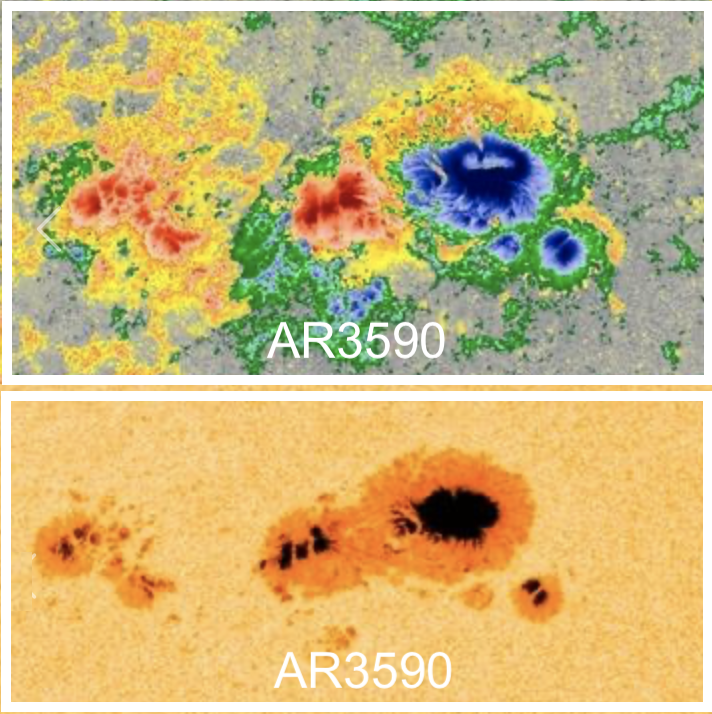

Sun news for February 23, 2024: Another X flare, even bigger this time!
The EarthSky sun news team created this video for you. Thanks for watching!
BAM again! Another X flare – the biggest of three fired in the past 24 hours – has exploded from active region AR3590. At X6.4, it’s the biggest flare of Solar Cycle 25 so far. The event started creating distortion on imagery equipment aboard the GOES-16 spacecraft at 21:56 UTC on February 22, but the peak wasn’t registered until 22:34 UTC. NOAA specialists issued an alert for impact over large sunlit areas, affecting radio frequencies for about an hour, and an R3 (strong) radio blackout was registered in an area over Easter Island in the South Pacific Ocean. The blast happened shortly after AR3590 fired an M4.8 flare at 21:04 UTC. We anticipate more major activity from this giant sunspot region, since it’s currently showing an unstable delta in its beta-gamma-delta configuration. Stay tuned for more.
Last 24 hours: Sun activity remains high after the X flare. Between 11 UTC yesterday and 11 UTC today the sun produced a total of 15 flares: one X, one M, and 13 Cs. The largest was of course the aforementioned X6.4 flare, fired by sunspot region AR3590 at 22:34 UTC on February 22. Once again, AR3590 was the leading flare producer of the period with a total 10 flares: the X, an M, and eight Cs.There is an as-yet-unnumbered newcomer in the northeast that has been flaring all day long. It blasted five C flares. Currently the sun bears just two labeled active regions on its Earth-facing side. The large coronal hole we have been observing is now in a geoeffective position, so soon we will start receiving the fast solar wind it produces. And we have another visitor in the SOHO spacecraft’s LASCO C3 imagery: Saturn. Take a look below – it looks gorgeous in the lower left, with Mercury also visible in the lower right. The two planets are getting closer from our perspective, and we will see a conjunction on February 28.
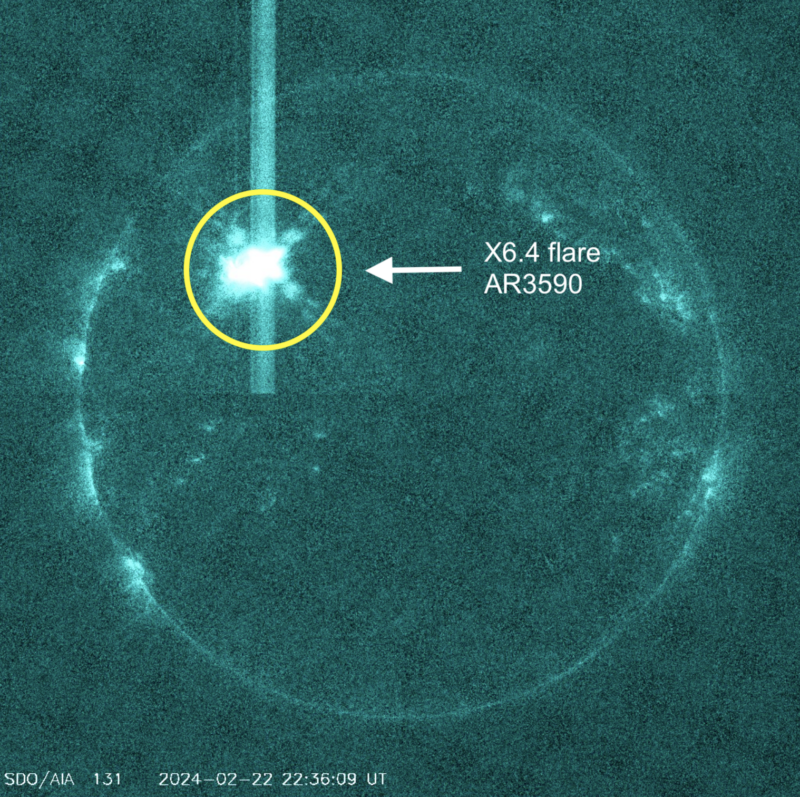

Major X6.37 flare from sunspot region 3590
Follow live on https://t.co/3Xxrvc3cpA pic.twitter.com/GMv1GwMmNr— SpaceWeatherLive (@_SpaceWeather_) February 22, 2024
Sun news for February 22, 2024: Double Bam! The sun releases two X flares
The EarthSky sun news team created this video for you. Thanks for watching!
Double BAM! During the past day the sun released two X flares from a big sunspot region, AR3590, on the sun’s northeast quadrant. X flares are the strongest category of solar flares. An X1.9 blasted at 23:07 UTC on February 21. And an X1.7 flare exploded at 6:17 UTC on February 22. The two X flares didn’t appear to release coronal mass ejections (CMEs) – big chunks of sun-stuff – during the events, but modeling and analysis are undergoing. AR3590 has been growing in size and magnetic complexity since it appeared on the sun’s northeast limb a couple of days ago. And it’s been quite productive overall. In addition to the two X flares, it produced a lot of little flares: 11 C flares during the past day (11 UTC yesterday to 11 UTC today). By the way – with proper eye protection such as eclipse glasses – you should be able to glimpse AR3590 on the sun’s visible disk. It’s big!
Last 24 hours: Sun activity is high. Besides the two X flares, flaring activity increased overall. The sun produced 17 flares between 11 UTC yesterday and 11 UTC today: the aforementioned two X flares, an M1.6 flare and 14 Cs. What a day! And we also saw a huge eruptive filament explode in the northwest around 15 UTC yesterday, hurling a big chunk of solar plasma into space. It’s being analyzed to see if it’s coming our way.
Here’s the list of the past day’s major flares:
X1.9 by AR3590 at 23:07 UTC on February 21. R3 (strong) radio blackout over Fiji Island on the South Pacific Ocean.
M1.6 by an incoming region on the southeast at 0:14 UTC. R1 (minor) radio blackout over South Pacific Ocean.
X1.7 by AR3590 at 6:17 UTC on February 22. R3 (strong) radio blackout over South Indian Ocean.
AR3590 was by far the leading flare producer, firing the two X flares plus 11 Cs. Currently the sun bears two labeled active regions on its Earth-facing side.
? ? ? ? X flares! AR3590 is busy today. First, it released an X1.9 at 22:52 UTC on February 21. Then came an X1.7 at 6:17 UTC on February 22. So far it appears no CMEs. We are waiting to see if the region has more in store.
MORE at EarthSky: https://t.co/xD29wLfm4e pic.twitter.com/UvKD95DUpF
— Dr. C. Alex Young (@TheSunToday) February 22, 2024
Sun news for February 21, 2024: Solar southeast wakes up with a huge blast
During the past few days, we’ve observed solar activity in the sun’s northeast, northwest and southwest, with the southeast remaining dormant. But not anymore! The southeast woke up earlier today with a huge blast, which hurled a gorgeous prominence of solar material into space at around 1:53 UTC this morning. The explosion came from the very edge of the southeast horizon, and was associated with an active region that is soon to rotate into view. And that’s not the only reason the southeast has grabbed our attention; the region has also been graced with a new coronal hole that emerged over the past day. Soon it will move into a geoffective position, meaning that the fast solar wind it produces will be headed our way at Earth. And that brings the possibility for beautiful auroral displays – stay tuned.
Last 24 hours: Sun activity remains low, with only 7 C flares produced between 11 UTC yesterday and 11 UTC today. The largest of these flares was a C4.4 flare, blasted in the southeast by an incoming as-yet-unnumbered active region at 2:17 UTC this morning. It was followed by another bright spark just below the equator on the east limb (edge). The lead flare producer title for the past day is shared by the unnumbered incoming region, AR3590 and AR3583, all blasting two C flares each. AR3590 remains the largest active region on the solar disk, and some growth was observed; it’s now showing a beta-gamma magnetic complexity. Although this classification suggests a strong flaring potential, it remained rather quiet, producing only faint C flares. The other two of the three labeled active regions on the sun show an alpha magnetic configuration – the most simple.
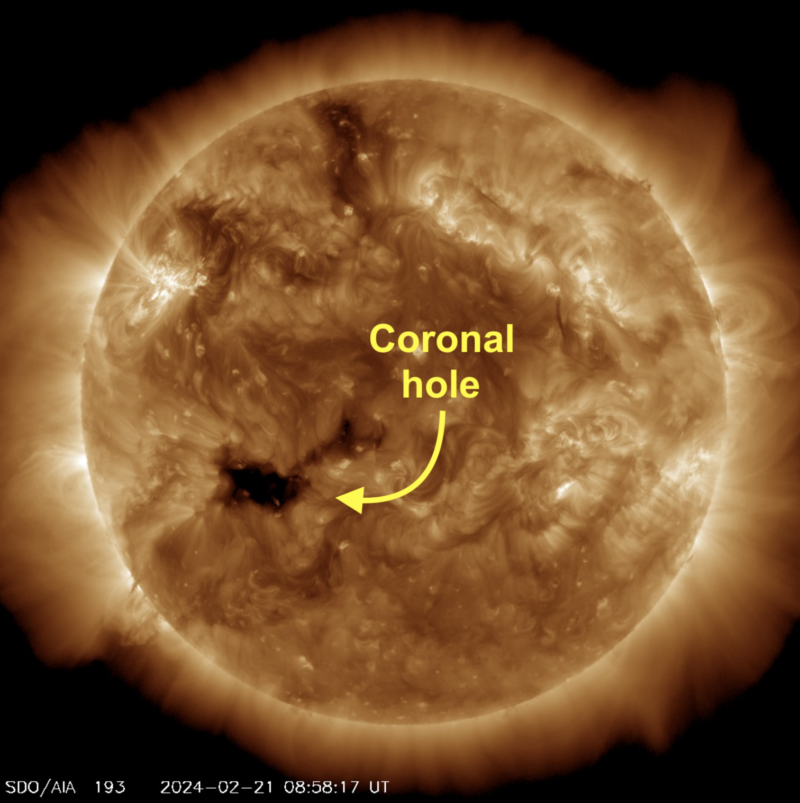
Sun news for February 20, 2024: Think of our sun as a star
The EarthSky sun news team created this video for you. We hope you enjoy it!
Overnight according to clocks in the Americas, a huge blast occurred on a part of the sun we can’t quite see from Earth. We know this because it produced a massive rope of plasma and magnetic fields that appeared over the solar southwest horizon. This rope is known as a prominence. It likely came from sunspot group AR3576, which recently got carried off the solar disk by the sun’s rotation. If this sunspot group stays intact, it’ll arrive back into view on the other horizon in around a couple of weeks. That’s because our sun completes a full rotation in about 25 days at the equator, and a little longer at the poles. So, yes, although we tend to visualize our star as a flat disk in the sky, it’s really a colossal sphere, occupying the same 3D space as 1.3 million Earths. And, while the sun is certainly massive in contrast to our little Earth, it’s only an average-sized star. The biggest star we know of, UY Scuti, is 1,700 times wider than the sun! So even our gigantic sun is still a drop in the ocean of the universe.
Last 24 hours: Sun activity is low, with only 7 C flares produced over the past day. The largest was a C5.7 flare produced by sunspot region AR3590 at 12:47 UTC on February 19. This region was the lead flare producer of the past day with four flares, shortly followed by AR3583 with three. AR3590 is the largest sunspot region on the solar disk, and can be seen without any magnification if you wear the proper eye protection, such as eclipse glasses. Currently the sun bears five labeled active regions, all of which are stable or in decay. In the northwest, the long-lasting prominence we have been observing since yesterday ended with ejecta dancing above the solar horizon. Most of the plasma was returned to the solar surface by the sun’s gravity. Yesterday’s huge prominence in the northeast was registered by the SOHO spacecraft’s LASCO C2 and C3 instruments, showing the characteristic lightbulb shape of a coronal mass ejection (CME). Take a look at our LASCO imagery below.
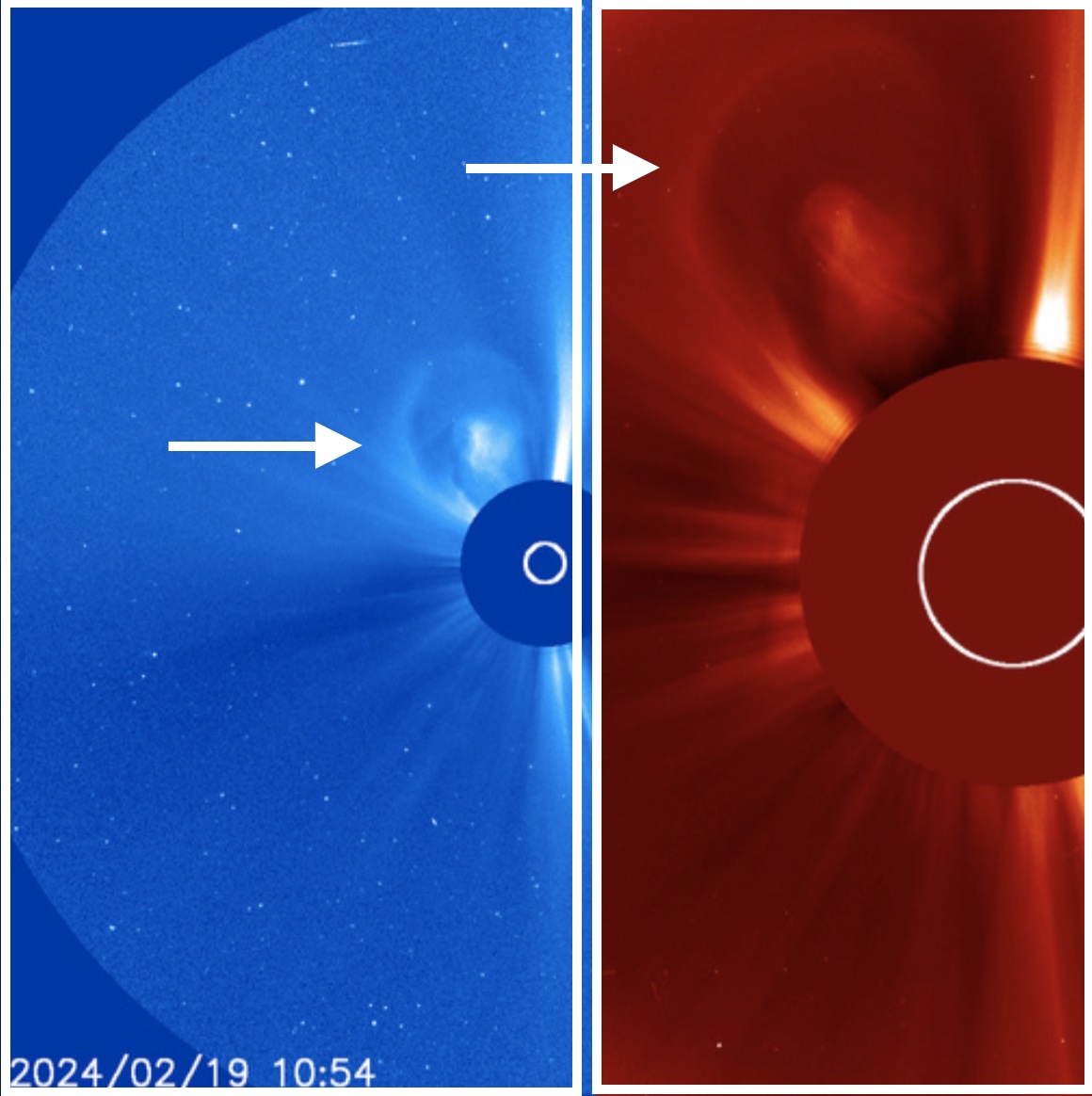
Sun news for February 19, 2024: Hi, Mercury!
The EarthSky sun news team created this video for you. Thanks for watching!
Today, we welcome Mercury as it enters the field of view of the SOHO spacecraft’s LASCO C3 imagery. It looks beautiful, and it’ll be fun to watch in the coming days as it crosses the sun’s field of view. Mercury is our sun’s innermost planet. It’ll appear near the sun in our sky six times in 2024, crossing either generally behind or generally in front of it as seen from Earth. Mercury’s current crossing is a passage behind the sun. It’ll appear most behind the sun as seen from Earth at around 9 UTC on February 28. Astronomers call this a superior conjunction of Mercury. Meanwhile, a newcomer sunspot region – now labeled AR3590 – has rotated fully into view, making a grand entrance. That is, as it was coming, we saw a fiery northeast limb (edge) on the sun, with a big far side explosion. The explosion came from a long-lasting prominence beyond the northeast horizon. BOOM! The prominence ended in an explosion, and the huge blast hurled large amounts of ejecta into space. At the same time, hello newcomer AR3590! We might expect great things from AR3590, as it is also quite active. Even when it wasn’t quite visible and still unnumbered, we saw it blasting C flares. Now that we can take a look at this guy, it looks big. It’ll surely be the next interesting sunspot region to follow, now that last week’s hero, AR3576, has been carried out of view by the sun’s rotation. Stay with us.
Last 24 hours: Sun activity is low. The sun produced 11 C flares during the past day (11 UTC yesterday and 11 UTC today). The largest was a C6.8 flare blasted by active region AR3590 at 9:40 UTC on February 19. Today we have shared honors for lead flare producer, AR3583 and AR3590, which each produced four C flares. But AR3590 produced the largest of the period. We saw a rather calm solar disk with faint C flares, but there is fiery activity – enormous long-lasting prominences – on three corners of our sun: northeast, northwest and southwest. The sun bears six labeled active regions today. All of them are showing an alpha or beta magnetic configuration, indicating a low potential for flaring. But, for now, it’s still too early to discern a full analysis on AR3590, due to its location too close to the sun’s limb (making us a foreshortened view).
Sun news for February 18, 2024: Huge prominence from solar south pole
The EarthSky sun news team created this video for you. Thanks for watching!
On our side of the sun, activity is low. We’ve had C flares only. But, during the past day, it seems the far side has been active! We saw a fast and huge prominence coming out from the sun’s south polar region. The SDO spacecraft captured its image at 13 UTC on February 17. The large prominence dwarfed the size of Earth, which would be minuscule in contrast. The LASCO C2 coronagraph aboard the SOHO spacecraft registered the explosion at 13:36 UTC. And its brother instrument – LASCO C3 – registered it at 13:54 UTC. LASCO C3 also shows it produced a partial halo event. If we see a partial halo from an event on our side of the sun, we know a coronal mass ejection (CME) is likely headed our way. But, since this prominence blasted off from the sun’s far side, the CME is not Earth-bound.
Last 24 hours: Sun activity is low, with the production of only C flares during the past day (11 UTC yesterday and 11 UTC today). The sun produced 13 C flares and the largest of them was a C7.9 flare blasted by active region AR3584 at 18:34 UTC on February 17. Lead flare producer of the period was an incoming active region on the northeast, unnumbered yet, who produced six C flares followed by AR3583 producer of four flares. Our just-departed hero AR3576 still is making noise from the far side via gorgeous prominences and jets on the visible sun’s southwest limb. The sun currently has six labeled active regions on its Earth-facing side, all of them showing an alpha or beta magnetic configuration, indicating a low potential for large flares.
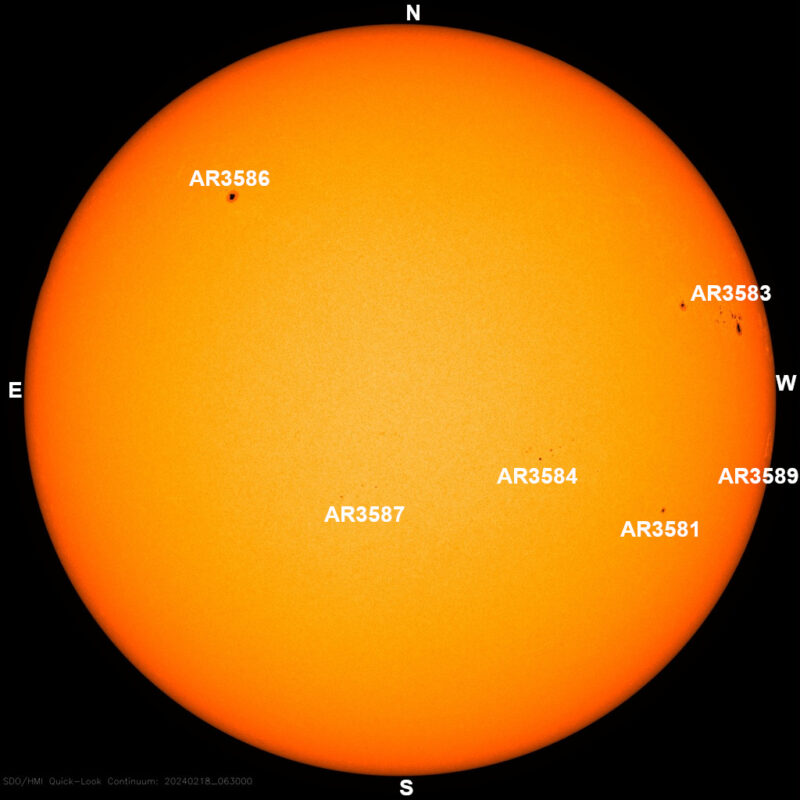

Sun news for February 17, 2024: Calm after the storm. Sun activity at moderate
- Sun activity back to moderate with the production of an isolated M flare.
- Only faint flares and jets on the solar disk.
- Flaring productivity reduced as well, with only eight flares in the last 24 hours.
The calm comes after the storm. Sun activity is back to moderate levels with an M3.0 flare. The producer (you are not going to believe this): AR3576! This guy does not want to leave. It produced six flares, the M included. AR3576 blasted the flare at 22:09 UTC on February 16, 2024, as it departs on the southwest limb (edge). We also saw jets and prominences from this region as it makes its way to the far side of our sun.
Last 24 hours: Sun action during the past day consisted of faint jets and plasma lifting here and there all over the solar disk. Besides AR3576’s action, there was a filament explosion on the northeast at around 16:20 UTC in the vicinity of sunspot region AR3586. It’s associated with a C6.2 flare in this active region. Between 11 UTC yesterday and 11 UTC today, there were 11 flares, an M plus 10 Cs. An R1 (minor) radio blackout over the Fiji Islands in the middle of the South Pacific Ocean resulted from the M flare. The sun currently has seven labeled active regions on its Earth-facing side.
Sun news for February 16, 2024: BAM! X flare!
The EarthSky sun news team created this video for you. Thanks for watching!- BAM! X flare! Departing region AR3576 erupts with a humongous flare and prominence before leaving.
- Solar maximum is showing itself, with flares and prominences all over the sun today.
X flare! Departing sunspot region AR3576 is leaving in style, erupting with an X2.5 flare and producing a huge prominence over the sun’s western limb (edge) earlier today. The blast caused an R3 (strong) radio blackout over the South Indian Ocean. This large region has been a champion of activity over the past weeks. We’re sad to see it go, as it rotates out of view over the western horizon. Given that the region is so far off to the solar west, you might think today’s blast wasn’t Earth-directed. In fact, a region on the sun’s western limb has a good chance of being magnetically connected to Earth. The sun’s magnetic field comes out in a spiral, like a lawn sprinkler (called the Parker spiral). This spiral creates a magnetic super-highway, allowing solar energetic particles released during a large eruption to travel along the magnetic field to Earth. In fact, we saw this very effect earlier this week. So far we’ve not seen a rise in measured particles, but we’ll keep you updated.
Last 24 hours: Sun activity was high over the past day after the production of an X flare, the strongest flare category. The event was an X2.5, blasted by the week’s most active region, AR3576, at 6:53 UTC on February 16. The eruption came with a huge, gorgeous prominence that hurled plasma into space. Shortly after the flare an R3 (strong) radio blackout affected an area over the South Indian Ocean. The past day has been a great show of a sun at Solar Maximum; we also saw large prominence eruptions all around the sun, both from the Earth-facing side and the far side. Most of the eruptions were not Earth-directed, but some may be – we await further analysis. The sun produced 17 flares between 11 UTC yesterday and 11 UTC today: an X, two Ms, and 14 C flares. The largest was the aforementioned X2.5 flare by sunspot region AR3576. Once again AR3576 was the lead flare producer of the period, with 13 flares out of the 17: the X, the two Ms and 10 Cs. Impressive stuff! Although it’s soon to rotate out of view, this region could still release some more big flares from over the limb (edge). The sun currently has seven labeled active regions on its Earth-facing side.
? ? Sun news for February 16, 2024: Bam! X flare!
? Departing region AR3576 erupts with a humongous flare and prominence before leaving.
? Solar maximum shows itself, with flares and prominences all over today.
? MORE at EarthSky: https://t.co/xD29wLfm4e pic.twitter.com/HphiMVYLXp
— Dr. C. Alex Young (@TheSunToday) February 16, 2024

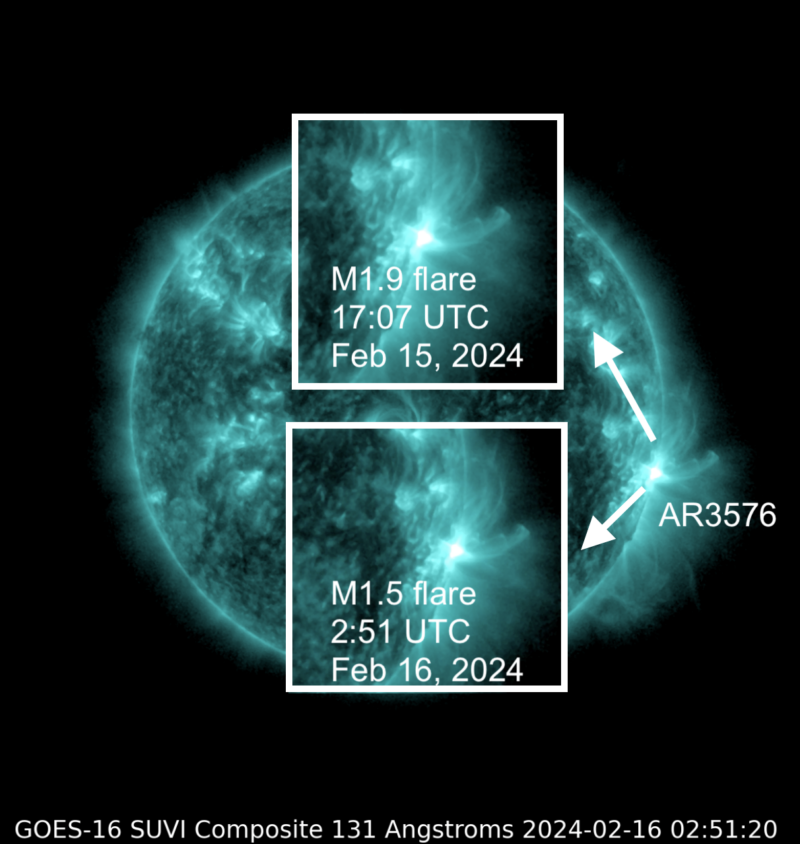
Sun news for February 15, 2024: Big blast from new sunspot region
??Sun news for February 15, 2024: Newcomer sunspot region and its big blast
?The region in the NE shows off potential by saying hello with a big entrance, releasing a huge prominence.
?Departing AR3576 is the main flare producer,
?MORE at EarthSky: https://t.co/xD29wLfm4e pic.twitter.com/FShpTsw1TY
— Dr. C. Alex Young (@TheSunToday) February 15, 2024
- A newcomer active region on the northeast showed off its potential, saying hello with a huge, gorgeous prominence.
- Soon-to-depart AR3576 was by far the most active region, flaring all day long.
Newcomer sunspot region AR3586 introduced itself this morning with a huge prominence eruption. The coronal mass ejection (CME) it produced was unlikely to be Earth-directed, as the sunspot group is too far to the northeast, but we await a full analysis of the event. And from a newcomer active region to one that is soon to depart, sunspot region AR3576 was again the leading flare producer. It fired off an impressive 18 C flares from near the southwest horizon, where it will soon rotate out of view. It would have been a very quiet day if it had already departed; if not for a C5.1 flare from AR3586 and a couple of last-minute flares from an as-yet-unnumbered region in the southeast, AR3576 would have been the past day’s only flare producer.
Last 24 hours: Sun activity was low during the last 24 hours. The sun only produced 21 C flares between 11 UTC yesterday and 11 UTC today. The largest was a C7.5 flare by sunspot region AR3576 at 17:56 UTC on February 14. AR3576 was also the lead flare producer of the period, with 18 C flares out of the 21. This region is still the largest in extent, and it maintained its beta-gamma-delta magnetic complexity, meaning it’s got the potential for M flares and even X flares. Although it’s soon to rotate out of view, it could still release some big flares from over the horizon. The sun currently has seven labeled active regions on its Earth-facing side, including new kid on the block AR3586.
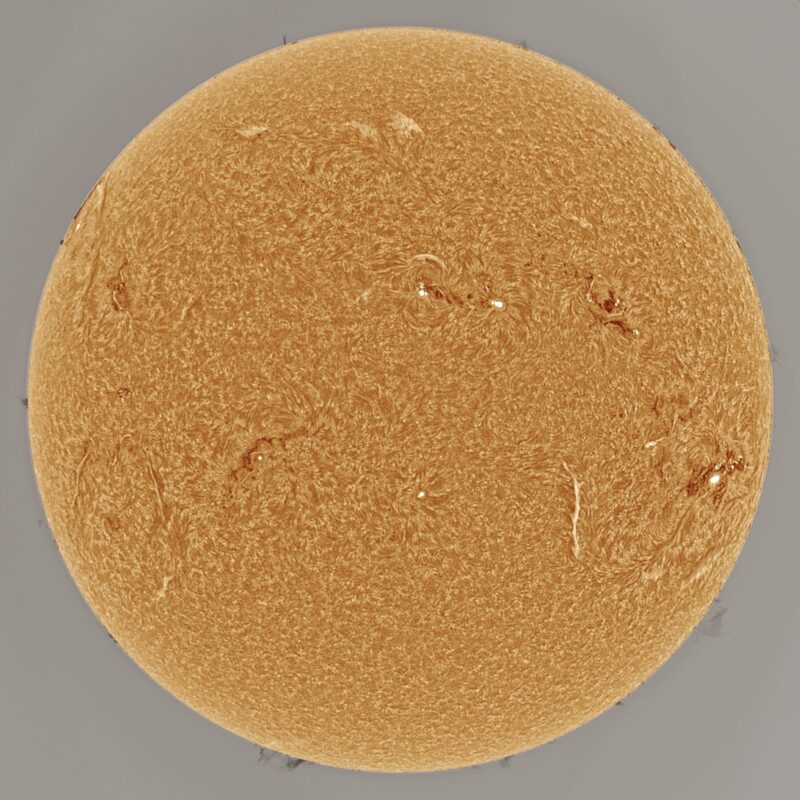
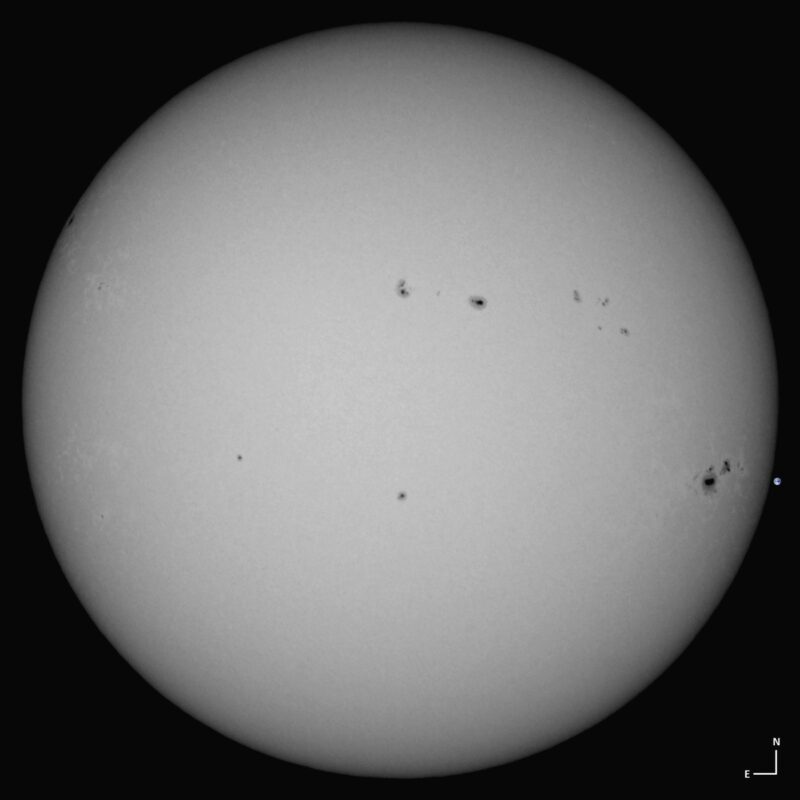
Sun news for February 14, 2024: With love, The Sun
The EarthSky sun news team created this video for you. Thanks for watching!- The sun’s visible gifts to us on February 13-14 include M flares and coronal mass ejections, with solar prominences dancing over the northern limb and some lifting off into space!
- A significant eruption from the sun’s far side in the past day suggests potential solar activity in the days ahead, as this far-side region rotates into our view.
- Deadly solar energetic particles continue to strike the SOHO spacecraft, highlighting the importance of understanding the sun and its effects as we go forward into the space age, and toward the future of humanity on Earth.
The sun has brought us many exciting gifts over the past day. The first of several coronal mass ejections (CMEs) has reached us, promising auroral displays. Several M flares, or moderately sized flares, lit the sun’s atmosphere. Prominences danced over the sun’s northern limb (edge), and some lifted off into space. And a huge eruption blasted off from the far side of the sun; it shows us what might be in store on the sun’s visible face, as this active region rotates into our view. But the sun’s love can also turn deadly, in the sense that solar energetic particles, produced by two major eruptions on the sun’s western limb (edge) a few days ago, continue to pound the SOHO spacecraft. Fortunately for us humans, our planet Earth, with its thick atmosphere and large magnetic field, provide ample protection to keep us safe here on the ground. Out in space is another story. That’s one reason we, as a civilization, stand vigil on our star via spacecraft like SOHO. The sun is our benefactor. But some of its gifts (such as its deadly radiation from events like those in recent days) create a challenging space environment. For the sake of our bodies, and our technologies, we need to be as knowledgeable as possible about our star and its ways, as we expand beyond this big blue marble!
Last 24 hours: Sun activity continues at moderate levels thanks to a couple of M flares during the past day. Flaring production during the period between 11 UTC yesterday and 11 UTC today is: 15 Cs and two Ms. The largest event was an M1.1 flare from AR3582 at 3:10 UTC on February 14. A corresponding R1 (minor) radio blackout affected an area over Australia. It was followed by a M1.0 flare by AR3576 at 7:35 UTC on February 14. There was a R1 (minor) radio blackout over South Indian Ocean, east of Madagascar. A new growth was observed during the period on sunspot region AR3576, which recovered its high-potential delta magnetic complexity, now showing again a beta-gamma-delta. It is rapidly approaching the southwest limb for departure. Expectations on a spectacular farewell grow along with its regained delta. It remains the largest sunspot group, visible from the ground without any magnification if you wear the proper eye protection, such as eclipse lenses. AR3576 keeps the lead flare producer position, with nine flares produced, an M and eight Cs. A gorgeous prominence on the top northwest limb (edge) dancing for hours and finally hurled a chunk of plasma into space and made it look like floating plasma off the solar disk.
? ? Sun news for February 14, 2024: Happy Valentine’s Day from the sun!
? ? The sun has brought us many exciting gifts.
? MORE at EarthSky: https://t.co/xD29wLfm4e pic.twitter.com/ArM1VNaL9H
— Dr. C. Alex Young (@TheSunToday) February 14, 2024
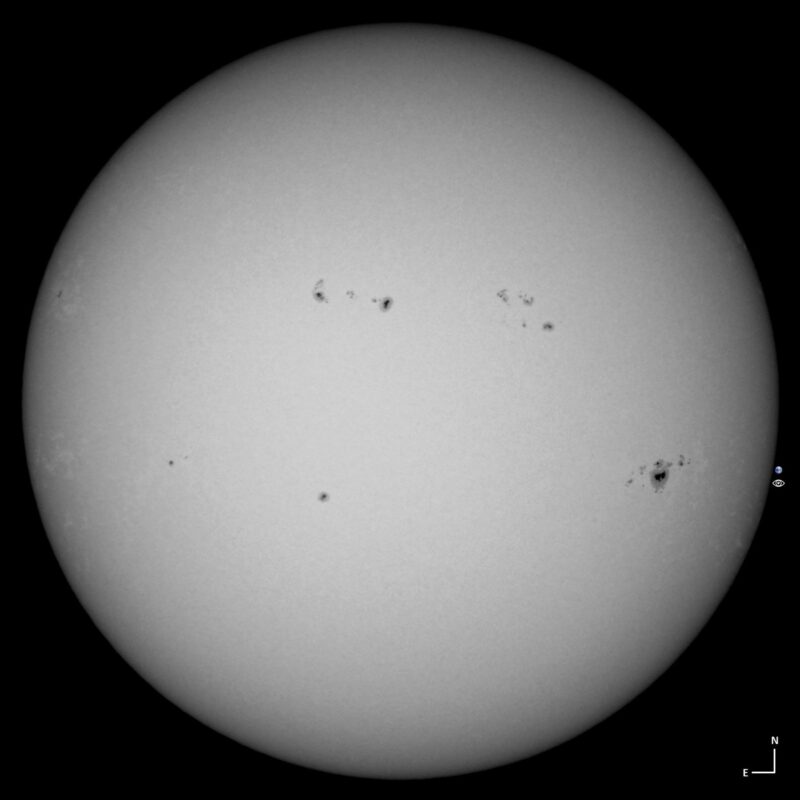
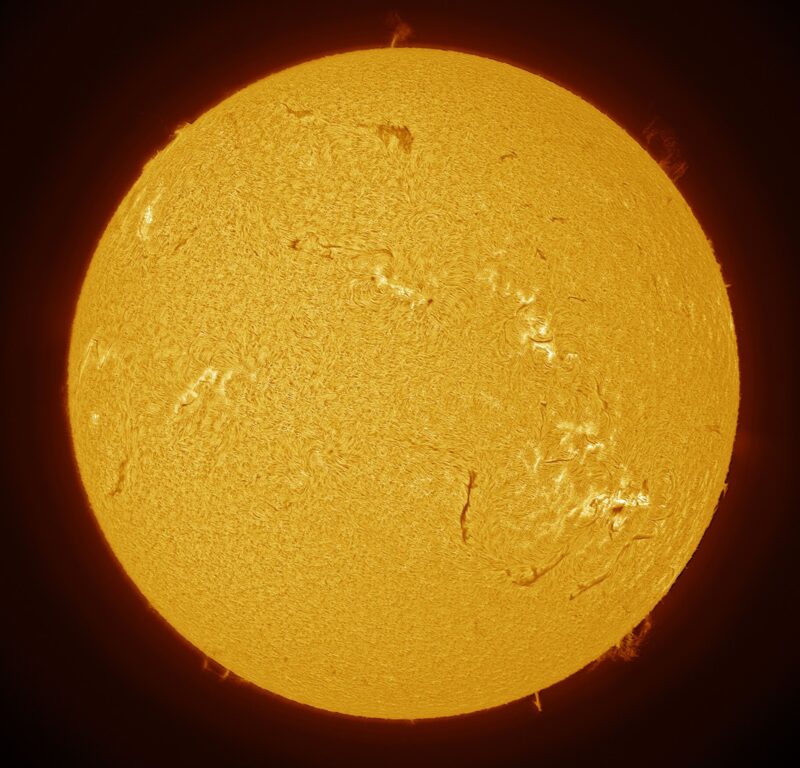
Sun news for February 13, 2024: Auroras incoming from cannibal CME
The EarthSky sun news team created this video for you. Thanks for watching!- The sun hurled multiple coronal mass ejections (CME) toward Earth on February 10 and 11.
- The most recent CME may catch up with the others, merging into one larger blob of sun-stuff: a cannibal CME.
- It will arrive today, possibly causing a G2 (moderate) geomagnetic storm. And that could bring auroral displays in northern latitudes.
A cannibal CME is coming! It sounds scary, but the result is likely to be beautiful auroras. The sun hurled multiple coronal mass ejections (CMEs) toward Earth on February 10 and 11, and analysis suggests that the most recent CME may catch up with the others, merging into one larger blob of sun-stuff: a cannibal CME. This is expected to arrive today, possibly disturbing Earth’s magnetic field enough to cause a G2 (moderate) geomagnetic storm. And that could bring auroral displays in northern latitudes, as far south as the U.S. states of Oregon and Maine. Clear skies, aurora chasers! Meanwhile, the sun is not easing up in its ferocious activity. Over the past day we observed three massive blasts on both the east and west limbs (edges). Nothing has been fired to Earth this time, but wow – these were spectacular. Check them out in the video above.
Last 24 hours: Sun activity remains moderate after the production of four M flares during the past day. Between 11 UTC yesterday and 11 UTC today the sun produced a total of 14 flares, with 10 Cs adding to the M flares. Here’s a breakdown of the M flares:
M1.1 flare by AR3576 at 13:08 UTC on February 12. R1 (minor) radio blackout over the South Atlantic Ocean.
M1.5 flare by AR3576 at 15:48 UTC on February 12. R1 (minor) radio blackout over Brazil.
M2.7 flare by an as-yet-unnumbered active region incoming in the northeast at 21:17 UTC on February 12. R1 (minor) radio blackout over French Polynesia.
M1.6 flare by AR3576 at 22:04 UTC on February 12. R1 (minor) radio blackout over French Polynesia.
Our hero of the past week, sunspot region AR3576, showed some decay and lost its high-potential delta magnetic complexity. But it remains the largest sunspot group, visible from the ground without any magnification if you wear the proper eye protection, such as eclipse lenses. AR3583 also decayed and lost its beta-gamma complexity. The rest of the seven labeled sunspot regions all have simple alpha configurations. AR3576 was the lead flare producer, with three Ms and four Cs. A gorgeous prominence on the top northeast limb (edge) hurled a chunk of plasma into space and left beautiful displays of coronal rain behind.
? ? Sun news for February 13, 2024: Auroras in the forecast! Massive blasts from the limbs
? ? Auroras in the forecast!
? ? The sun is also busy with three massive blasts from both the East and West limbs (edge).
? MORE at EarthSky: https://t.co/xD29wLfm4e pic.twitter.com/UuHs9Ry3TU
— Dr. C. Alex Young (@TheSunToday) February 13, 2024
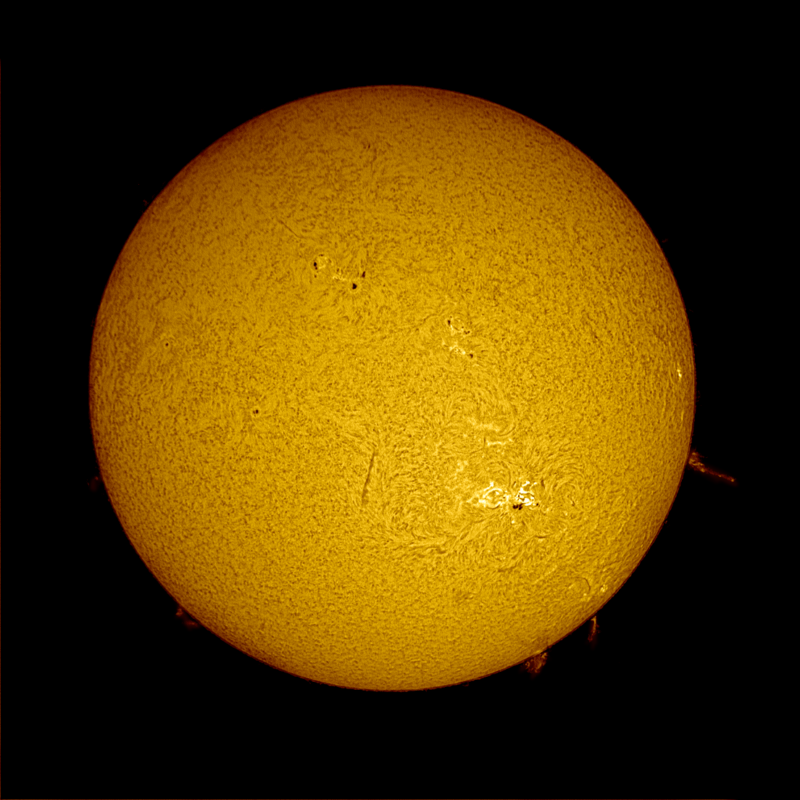
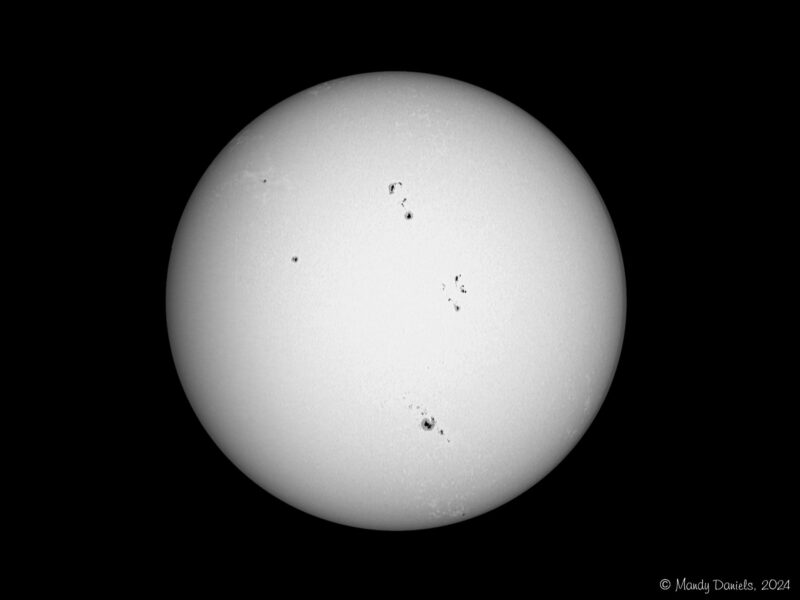
Sun news for February 12, 2024: Another one! What fun!
The EarthSky sun news team created this video for you. Thanks for watching!- We had an X flare on February 9, an almost-X flare on February 10, and another strong M6.5 flare earlier today. And why not? We’re near the peak of the sun’s 11-year cycle of activity.
- This morning’s flare is still under analysis, but it was mostly south-directed and will likely miss Earth.
- Glancing blows from solar CMEs are expected late on February 12, and again on February 13. That could mean auroras!
We’ve had a glorious past few days of sun activity! And why not? The peak of the sun’s 11-year cycle could be this year. Remember the X flare on February 9? Then we had an almost-X flare on February 11. And, earlier today, it was deja vu all over again, with sunspot region AR3576 – in the sun’s bullseye and still looking straight at Earth – releasing another strong flare, an M6.5. Just as with the M9 flare, this eruption caused a coronal wave and coronal dimming, suggesting another fat CME. The CME spacecraft images appear to show mostly a southward-aimed event – in other words, not coming Earth’s way – but we await more information to determine if there is an Earth-directed component. The event also produced a blast of high energy particles appearing as snow on SOHO (Solar and Heliospheric Observatory) images. The particles have currently reached the S1 radiation storm level, but don’t worry. Earth’s atmosphere protects us from them. Meanwhile, SDO images and GOES SUVI images show a huge eruption on the sun’s far side. And the SDO (Solar Dynamics Observatory) images show the bright core, with SUVI showing the extended prominence. It all looks quiet dynamic! And it’s been an exciting past few days! Stay tuned for more.
Last 24 hours: Sun activity levels are moderate. Between 11 UTC yesterday and 11 UTC today, the sun produced 15 C flares and two M flares. The largest event was an M6.5 from AR3576 at 03:23 UTC on February 12. Most of today’s flares came from AR3576 but the other M flare, an M1.1, came from an unnumbered region on the NE limb (edge). Both M flares produced radio blackouts. The M1.1 event produced an R1 blackout over the Pacific, and the M6.5 flare produced an R2 blackout over Indonesia and Australia. A large filament eruption occurred on the far-side around 6:30 UTC on February 12, 2024. It was captured in the wide field of view of the GOES SUVI telescope, the 304 angstrom wavelength channel. AR3576 has kept its beta-gamma-delta magnetic complexity. It has decayed some, decreasing about one Earth in size. It is still over three Earths in surface area. Region AR3583 has increased in magnetic complexity to beta-gamma. The sun has seven sunspot regions on its Earth-facing side.
Sun news for February 11, 2024: Almost-X flare from sun’s bullseye
Sunspot region AR3576 erupted with an almost-X flare – an M9 – near the center of the sun’s visible disk late yesterday. The flare happened at 22:56 UTC on February 10, and we all got excited. Would the eruption send a chunk of sun-stuff – a CME – our way? And would we then get a great auroral display? The eruption did send a coronal or EIT wave out, blowing out a huge bubble of solar plasma with it. It caused a nearby area on the sun to darken in a wavelike fashion, creating what’s called a coronal dimming. A fast coronal mass ejection (CME) was measured, moving at about 4.3 million miles per hour (7.2 million km/h). But aimed Earth’s way? No. The CME was directed northward. So it is not expected to hit Earth directly, but might give us a glancing blow, forecast for February 13. It could still bring a G1 (minor) geomagnetic storm and aurora. Stay tuned.
Last 24 hours: Sun activity levels are moderate. Between 11 UTC yesterday and 11 UTC today, the sun produced 11 C flares and one M9, an almost-X flare from AR3576. The almost-M flare created a temporary R2 radio blackout over the Pacific Ocean yesterday. Otherwise, the high-energy protons associated with the February 9 X flare continued over the past day, but at a reduced level. They are now at the S1 radiation storm level. A filament erupted from the northeast at the end of our observing period (11 UTC yesterday to 11 UTC today). A prominence dancing around the north pole slowly separated into space. Though no longer in a position for us to see flaring from it, AR3575 released a large back side eruption around 7 UTC today. The sun has seven numbered active regions today.
? ? Sun news for Feb 11, 2024: Almost X flare and CME from disk center
? ? AR3576 erupted with an almost X flare, M9. The eruption sent a coronal/EIT wave northwestward, blowing out a huge bubble of solar plasma with it.
? MORE at EarthSky: https://t.co/xD29wLfm4e pic.twitter.com/2qPykDEuwM
— Dr. C. Alex Young (@TheSunToday) February 11, 2024
Sun news for February 10, 2024: Powerful X flare blasts particles from the limb
? ? ? ? ? Kaboom!! Another look at the X flare – X3.4 from AR3575 around the W limb. It produced a fast CME over 2,000 km/s, 7.2 million kph. The location sent particles our way showing up as snow on the camera showing the CME.? ?
MORE at EarthSky: pic.twitter.com/jdT40RK8o0
— Dr. C. Alex Young (@TheSunToday) February 9, 2024
C. Alex Young posted the above video on X/Twitter and said: “Kaboom!! Another look at the X flare – X3.4 from AR3575 around the W limb. It produced a fast CME over 2,000 km/s, 7.2 million kph. The location sent particles our way showing up as snow on the camera showing the CME.”
X flare! This most powerful category of solar flare peaked 13:14 UTC yesterday. The X3.4 flare came from AR3575, which recently rotated out of view over the sun’s southwest limb (edge). Given its location, the sunspot region was partially occulted (blocked). That means the X flare was larger than X3.4. The X flare produced a strong, fast coronal mass ejection, or CME, now measured at over 2,000 kilometers per second or 7.2 million kilometers per hour (about 4.3 million miles per hour). Because of the flare’s position on the sun’s limb, however, any sun-stuff released by the CME is likely not headed toward Earth. Shortly after the blast, an R3 (strong) radio blackout affected an area over the South Atlantic Ocean. The eruption associated with the X flare created a surge of high-energy protons, traveling at close to the speed of light, that reached the SOHO spacecraft causing “snow” on the images from the LASCO coronagraphs. This solar energetic particle event, or SEP, caused the proton levels measured by the GOES spacecraft to first reach S1 and then eventually S2 alert levels shortly after the X flare. These particles appear to be leveling out, but they’re still elevated.
Last 24 hours: Besides the X flare, the sun also produced three M flares in the past day. This kind of activity is what we expect near Solar Maximum. An unnumbered, incoming region from the southeast produced one of the M flares. The event released a beautiful eruption visible in extreme ultraviolet and a CME seen in SOHO/LASCO. The northeast limb (edge) has enormous long-lasting prominences and coronal loops dancing on the limb, telling us that more action will soon rotate into view. So, no surprise that sun activity is high today. Between 11 UTC yesterday and 11 UTC today, the sun produced an X, three Ms and ten C flares for a total of 14 flares. Lead flare producer of the period: AR3576, which produced 10 flares, two Ms included. The largest was the X3.4 flare from AR3575. This is the second largest X flare of the solar cycle. The X and M flare breakdown is:
1. X3.4 (AR3575) at 13:14 UTC on February 9. R3 (strong) radio blackout over the South Atlantic Ocean.
2. M1.2 (AR3576) at 18:00 UTC on February 9. R1 (minor) radio blackout over the South Pacific Ocean.
3. M1.5 (AR3576) at 00:51 UTC on February 10. R1 (minor) radio blackout over Fiji Island.
4. M3.4 by an unnumbered, incoming region on the southeast at 3:54 UTC on February 10. R1 (minor) radio blackout over the northwest coast of Australia.
The sun has five active regions on its Earth-facing side.
C. Alex Young posted the above video on X/Twitter and said: “What a day! Action we anticipated from the southeast is visible from an incoming active region, producing an M flare. The event released a beautiful eruption.”???Sun news for Feb 10, 2024: The sun wakes up with an X flare, 3 Ms!
??What a day! Action we anticipated from the southeast is visible from an incoming active region, producing an M flare. The event released a beautiful eruption
?MORE at EarthSky: https://t.co/xD29wLfm4e pic.twitter.com/WfWDAfNNCN
— Dr. C. Alex Young (@TheSunToday) February 10, 2024
Sun news for February 9, 2024: X flare!
The EarthSky sun news team created this video for you. Some fun this morning! X flare! We hope you enjoy it.X flare! It peaked 13:14 UTC this morning. An X-flare is the most powerful category of solar flare. This X 3.4 flare came from AR3575, which has just rotated out of view over the sun’s southwest limb (edge). Given its location, the sunspot region was partially occulted (blocked). That means the X flare was larger than X3.4. It shows a clear eruption and coronal wave indicating a strong, fast coronal mass ejection, or CME. Because of the flare’s position on the sun’s limb, though, any sun-stuff released by the CME is likely not headed toward Earth. Otherwise … what a day the past day has been for the sun! Its journey towards Solar Maximum continues, with a massive 31 flares produced over the past day, including 6 M flares. We also saw more action on the northeast limb (edge), where enormous long-lasting prominences and coronal loops danced on the horizon, telling us that more action will soon rotate into view. And that’s exactly what happened in the southeast, where a long-awaited sunspot group finally made its full appearance. We’ve been observing its activity from over the horizon, and the region now has a name: meet AR3581. Stay tuned to see what it will bring.
Last 24 hours: Thanks to the X-flare, sun activity is now high. We had six M flares and 25 C flares between 11 UTC yesterday and 11 UTC today. Then we had the X flare after our deadline, centered on 13:10 UTC today. AR3575 apparently produced the X flare. And AR3576 produced four of the M flares and 16 of the C flares. Other than the X flare, the largest event was an M4.0, also from AR3575, at 23:55 UTC on February 8. AR3575 is now beyond the western horizon, meaning that the sun blocked much of what was actually larger than an M4 … and it means the X flare was larger than X3! Each M flare was followed by a corresponding R1 (minor) radio blackout affecting an area where the sun was high in the sky. The list of the M flares over the period is:
1. M3.5 by AR3576 at 13:12 UTC on February 8
2. M1.2 by AR3574 at 14:18 UTC on February 8
3. M1.8 by AR3576 at 15:23 UTC on February 8
4. M1.3 by AR3576 at 19:02 UTC on February 8
5. M4.0 by AR3575 at 23:55 UTC on February 8
6. M3.2 by AR3576 at 00:41 UTC on February 9
The sun has eight active regions on it Earth-facing side, including newcomer AR3581.
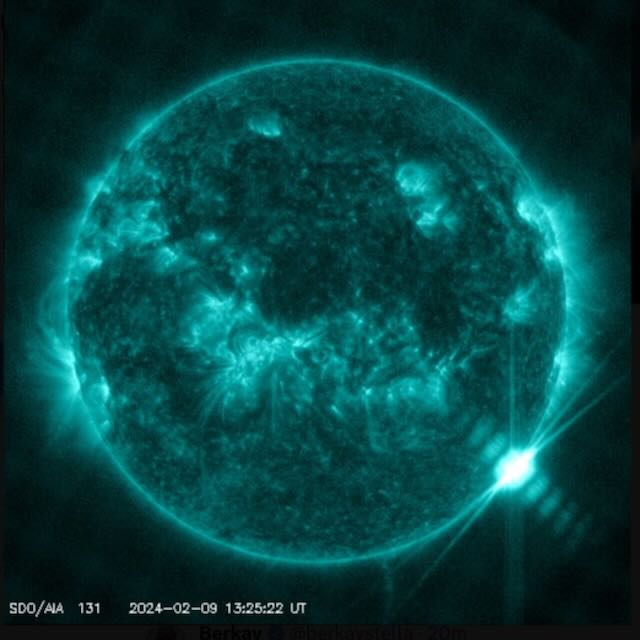
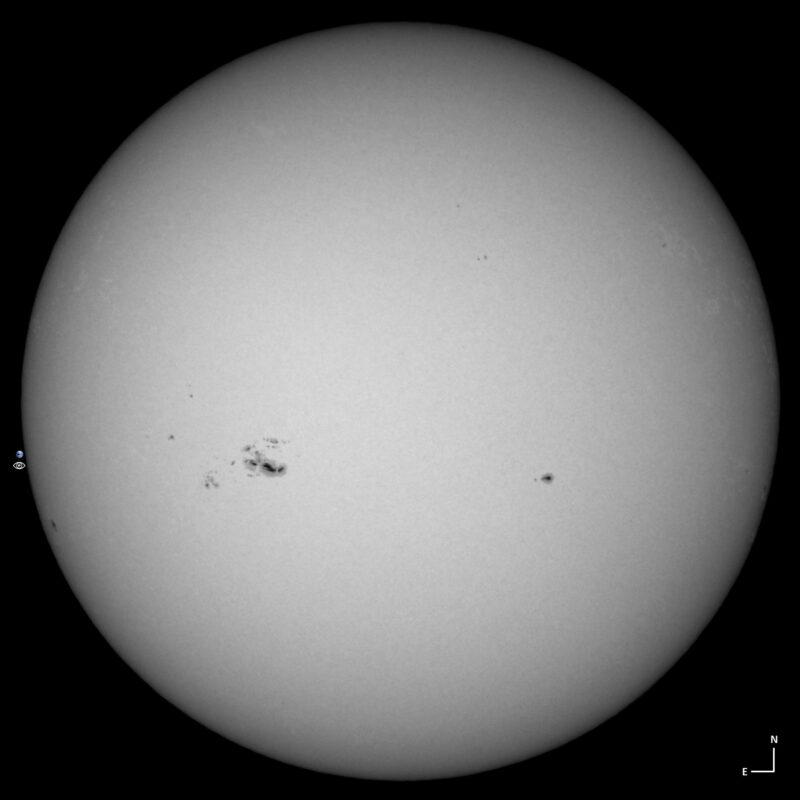
Sun news for February 8, 2024: Solar edge is teeming with activity
Keeping up the appearance of a sun reaching solar maximum, the solar limb (edge) is teeming with activity all around. Coronal loops from sunspot region AR3575 are visible over the western horizon, while a new region – potentially substantial in size – is producing coronal loops in the southeast. Plus, a prominence on the southern limb (edge) erupted in the past day. There were no notable eruptions on the solar disk, but AR3576 did produce an M1.4 flare yesterday evening. This region is still a strong candidate for substantial eruptions; its main sunspots have mixed magnetic polarity delta regions, which indicate the potential for M and even X flares.
Last 24 hours: Sun activity is moderate with the production of an isolated M1.4 flare. Fired from AR3576 at 18:05 UTC on February 7, this was the largest flare of the period. It produced an R1 (minor) radio blackout affecting an area over the South Pacific Ocean off the west coast of South America. Flare production between 11 UTC yesterday and 11 UTC today was 10 Cs and the one M flare. The lead flare producer was AR3576 with six flares. This sunspot group is the largest in extent and the most magnetically complex with a beta-gamma-delta magnetic configuration. The sun currently has eight labeled active regions on its Earth-facing side.
Sun news for February 7, 2024: Activity high after M5 flare and CME
EarthSky’s sun news team produced this video for you. It’s based on a viewer’s question, “Why do we follow the sun news?” Hope you enjoy it!Sunspot region AR3575, the producer of yesterday’s back-to-back M flares, released an even bigger M5.2 flare earlier today. It also produced an eruption that launched a coronal mass ejection (CME) westward. This region will soon rotate out of view over the western horizon, but it’s currently showing potential for much more activity before it’s gone. And the other major sunspot group we’ve been watching, AR3576, is not down for the count. Although quiet compared to AR3575, it carries a similar potential for big flares and eruptive activity. That includes potential excitement from the filaments that are surrounding the region. And even if these sunspot groups don’t deliver on their potentials, areas all around the limb (edge) are stirring with prominences, promising more action to come. Stay tuned!
Last 24 hours: An M5.2 flare from AR3575 has brough activity to high. It occurred at 3:04 UTC on February 7, and caused an R2 (moderate) radio blackout off the north coast of Australia. This was the largest of two M flares from the region over the past 24 hours, the second being an M1.3 flare at 18:38 UTC on February 6. It produced an R1 (minor) radio blackout off the west coast of South America. Between 11 UTC yesterday and 11 UTC today the sun produced 11 flares: two Ms and nine Cs. The lead flare producer was AR3575 with six Cs and the two Ms. It also fired off an eruption that produced a coronal mass ejection (CME) and a coronal or EIT wave. AR3576 kept its beta-gamma-delta magnetic complexity while AR3575 has a beta-delta configuration. Both both regions have the potential for more M and even X flares. These two regions are still the largest and most active of the eight numbered active regions currently on the sun’s Earth-facing side.
Sun news for February 6, 2024: Double M flare and filament eruption
The EarthSky sun news team created this video for you. Thanks for watching!Bam bam! Sunspot region AR3575 – one of two large active regions on the sun’s Earth-facing side right now – delivered back-to-back M flares earlier today. After watching the above video, you might be wondering: where’s the second flare? It does look like the one flare, but we know that two were produced because we can see two peaks in X-ray emissions during this event – see for yourself in the chart below. This double-M flare produced a spectacular filament eruption and coronal mass ejection (CME), a great burp of solar material and magnetic fields fired out into space. After the flares, an arcade of post-flare loops formed. AR3575 and AR3576 – the other large active region we’re watching – both now measure several times the size of Earth. And both carry the magnetic potential for more substantial activity!
Last 24 hours: During the past day, sun activity has been moderate with the production of two M flares. Between 11 UTC yesterday and 11 UTC today we saw two Ms and nine C flares. Here’s a breakdown of the M flares:
1. M2.2 flare by AR3575 at 2:28 UTC on February 6, causing an R1 (minor) radio blackout over Australia off the north coast.
2. M4.3 flare by AR3575 at 3:12 UTC on February 6, causing an R1 (minor) radio blackout over Australia.
The lead flare producer of the period was AR3576 with six C flares. AR3575 and AR3576 both show a promising beta-gamma-delta magnetic complexity. They are also the largest active regions currently, and you can see them without any magnification if you wear the proper solar viewing protection. A filament is erupting in the northwest. There are some large filaments near and wrapped around AR3576 that are worth watching. The sun currently has ten numbered active regions on its Earth-facing side.

Sun news for February 5, 2024: Fantastic flurry of M flares!
EarthSky’s C. Alex Young (a heliophysicist at NASA Goddard Spaceflight Center) and Deborah Byrd – members of our sun news team – produced this video for you. We hope you enjoy it! Eleven M flares in the past day! Sun activity is now high. And, wow, some of us here (but not Alex!) feel like soothsayers. Of course, it’s not soothsaying. It’s science! Early yesterday, we noticed that two regions – AR3575 and AR3576 – showed strong flaring potential. That’s due in part to their magnetic complexity. And AR3576 then went on to produce 10 of the past day’s 11 M flares, and 19 of a total of 25 flares in the past 24 hours. As for the coming day, overall flare probability is up, due to the sheer number of flares in the past 24 hours, not to mention the ongoing magnetic complexity of AR3575 and AR3576. And – as the sun’s rotation has carried AR3576 more into view – we’re better able to observe its size. And it’s a whopping 4.5 times as big as Earth! The chance of X flares – the strongest flares – on any given day is typically around 5-10%. But today’s it’s 25%!
Last 24 hours: Eleven M flares brought sun activity to high. Ten came from AR3576 and one from AR3575. The total flare production was 25 between 11 UTC yesterday and 11 UTC today. The largest event was an M2.7 from AR3576 at 22:34 UTC on February 4. The full list of M flares is:
M1.4 at 11:40 on Feb 4 (AR3576)
M1.5 at 16:22 on Feb 4 (AR3576)
M1.3 at 17:05 on Feb 4 (AR3576)
M1.1 at 18:16 on Feb 4 (AR3575)
M1.3 at 20:52 on Feb 4 (AR3576)
M2.1 at 22:20 on Feb 4 (AR3576)
M2.7 at 22:34 on Feb 4 (AR3576)
M1.8 at 22:45 on Feb 4 (AR3576)
M2.2 at 04:13 on Feb 5 (AR3576)
M1.5 at 04:36 on Feb 5 (AR3576)
M1.5 at 06:26 on Feb 5 (AR3576)
All of these flares caused R1 (minor) radio blackouts over the sun-facing side of Earth as each flare occurred. Radio blackouts are centered where the sun is highest in the sky at the time of the flare. AR3575 has decreased somewhat in size to about 1 1/2 times the area of Earth. AR3576 is much larger at 4 1/2 times the area of Earth. Both AR3575 and AR3576 have high magnetic complexity with delta regions. AR3575 is more complex with a beta-gamma-delta configuration. AR3576 is gamma-delta but its flare output indicates that it may be more complex. Because it has not fully rotated into view, an accurate magnetic complexity determination is more difficult. Over time, the probability of flaring has increased. Stay tuned to see if these regions bring us more excitement.
Sun news for February 4, 2024: 2 sunspot regions turn up the heat
EarthSky’s favorite solar astrophysicist Dr. C. Alex Young of NASA Goddard Spaceflight Center – and Deborah Byrd – produced this sun news video for you. Thanks for watching!
Today’s top news: Yesterday, the unnumbered sunspot region on the sun’s southeast limb – and a newly emerged region in the sun’s southwest – promised action. Now, both are humming along and might be poised to give us some strong flares. The unnumbered region, now labeled AR3576, released 20 of the past day’s 23 C flares. Around the same time, sunspot AR3575 in the southwest, exploded in size from nothing to nearly twice the area of Earth! These two regions – plus a third region, AR3565, which has increased in magnetic complexity – bring a strong promise of action across the sun. AR3575 now has a beta-gamma-delta magnetic configuration, giving it a strong flare potential. And AR3576 probably has significant magnetic complexity, too, given its prolific flaring in the past day. But this region needs to rotate better into view before its true potential can be properly determined. Stay tuned for more sun excitement!
Last 24 hours: Sun activity is low, but flaring amount has increased significantly with 23 C flares between 11 UTC yesterday and 11 UTC today. AR3576, the newly numbered region in the southeast, produced 20 of these flares, including the day’s largest event, a C6.4 at 21:29 UTC on February 3. AR3575 region grew significantly over the past 24 hours, growing in 3 days from nothing to a region nearly two Earths in area. Plus, AR3575 produced the day’s remaining 3 C flares.

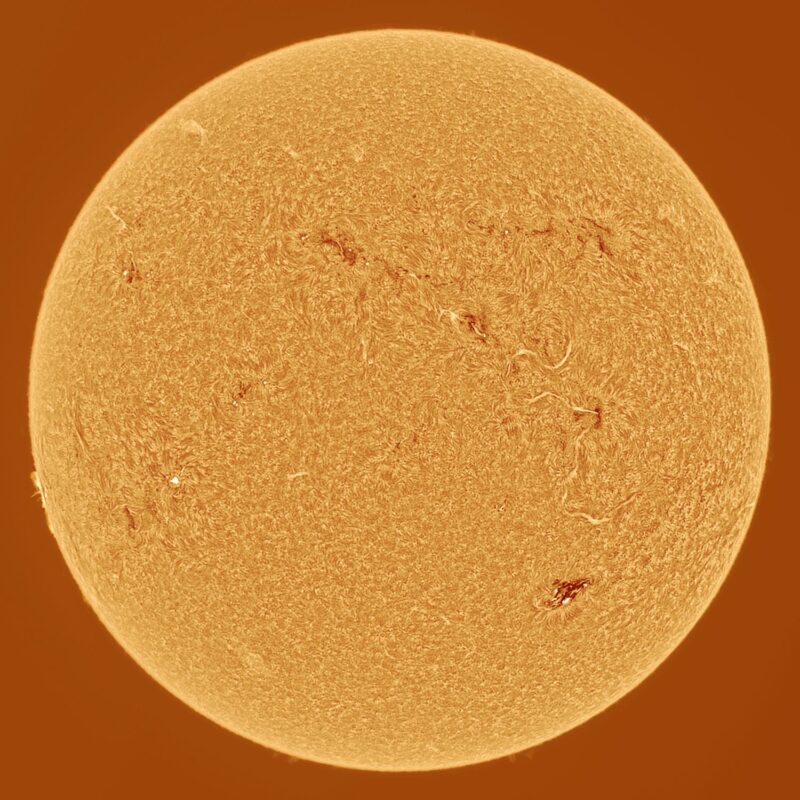
Sun news for February 3, 2024: A flurry of coronal jets
Sunspot region AR3571 released a flurry of coronal jets over the past day. These jets of plasma (ionized gases) shoot up from active regions and may help scientists better understand different phenomena on the sun. AR3571 also produced about of 1/3 of today’s flares along with its nearly continuous release of coronal jets. These may contribute to some coronal mass ejections (CMEs) toward Earth if this activity keeps up for a few more days. Plus, a new region hot on its heels may add to the excitement. The new, unnumbered region was still behind the southeast limb (edge), yet it was the main flare producer for the day, accounting for at least half of the flares. Helioseismology shows the region has the potential for more activity. These two areas will take about 26 days to rotate completely around the sun. So that means we should see them on the Earth-facing disk for roughly two weeks. If they continue with this level of action, we’ll have lots of time for some sun fun.
Last 24 hours: Sun activity is low with C flares during the past day. The sun produced 11 C flares between 11 UTC yesterday and 11 UTC today. The largest event was a C7.7 from from an unnumbered incoming active region on the southeast limb (edge) at 5:54 UTC on February 3. This region is the lead producer with five C flares. Active region AR3571 produced a few flares but with nearly continuous coronal jets. Active region AR3565 developed a beta-gamma magnetic complexity. The remaining regions are either alpha or beta. AR3571 is the largest region on the disk. Newcomer AR3575 emerged from nowhere in the middle west.
Sun news for February 2, 2024: The sun is losing mass!
The EarthSky sun news team created this video for you. Thanks for watching. And if you enjoy our videos, please subscribe, like and share!
Late last night, a beautiful prominence erupted in the northwest, sending a huge blob of solar plasma and magnetic fields into space. Soaring at several million miles per hour, this bubble of solar stuff included about a billion tons of matter. You might be wondering – how can the sun keep losing that much mass and still have enough mass to be a star? Well, a billion tons might be a phenomenal amount of mass, but it’s actually just a drop in the solar bucket. The solar wind – which the sun constantly releases into space – carries away about 1.6 million tons of mass per second. And even that is small compared to the amount of mass the sun loses by turning its stores of hydrogen into energy. Knowing how much of this energy the sun releases into space, we can use Einstein’s famous equation E=mc2 to calculate how much hydrogen mass the sun loses to form this energy: 4.7 million tons per second, or 3.3-with-17-zeros lbs. Think that seems huge? The sun contains 4.4 x 10 to the power of 30 lbs of mass, – that’s 4.4 followed by 30 zeros! So don’t worry – today’s prominence may have fired out a lot of matter, but the sun still has enough to continue for another 5 billion years.
Last 24 hours: An isolated M flare has raised sun activity to moderate. AR3571 produced the M1.2 flare at 3:01 UTC on February 2. Shortly after the eruption, an R1 (minor) radio blackout affected an area over the north coast of Australia. There was no flare associated with the huge prominence in the northwest, but it occurred in the vicinity of our old friend AR3559, which passed over the horizon just yesterday. The total flare production between 11 UTC yesterday and 11 UTC today was 16 flares: the M1.2 and 15 Cs. AR3571 was the lead flare producer of the period with 8 flares including the M flare. The sun has seven sunspot regions on its Earth-facing side, including five newcomers: AR3570, AR3571, AR3572, AR3573 and AR3574.
Sun news for February 1, 2024: Prominence action on the edge
Our attention has been drawn to the solar limb (edge) all of this week, and the same is true today; prominences have been dancing around on all edges of the sun over the past 24 hours. And, even though sunspot region AR3559 has departed over the western limb, the action is now coming from unnumbered regions arriving in the southeast, and regions just over the southeastern horizon. Similarly, although the coronal holes we have been monitoring have now gone, a new hole has just developed in the south near the central meridian. When one door closes on the sun, another tends to open! That’s especially true with the sun approaching solar maximum, likely over the next year. January saw some short bursts of exciting activity – stay tuned to see what February will bring.
Last 24 hours: The sun produced 13 C flares during the past day, keeping activity at low. Between 11 UTC yesterday and 11 UTC today, the largest event was a C3.1 flare from an unnumbered region in the northeast at 7:43 UTC, February 1. Sunspot region AR3567 was the leading flare producer, and it also developed a beta-gamma magnetic complexity, indiciating an increased potential for larger flares. The sun currently has five sunspot regions on its Earth-facing side. There is a newcomer in the southwest, AR3569.












